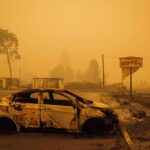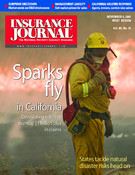While the losses from Southern California’s wildfires are still being tallied, parallels are being drawn between October’s blazes and 2003’s Cedar and Old Fires, which struck in many of the same areas. Some agents and brokers say the damage is greater this time around. Fortunately, they say they were better prepared.
Daniel Howell, senior vice president of Alliant Insurance Services, described the current situation as “extraordinarily more severe” than the fires of 2003. He has been up and down the coast of Southern California and said the site is truly unbelievable, with smoke going miles out to sea, and mountainsides and structures completely engulfed in flames, as far as the eye can see. Even those who are not directly in the immediate danger zone are suffering due to the poor air quality, he commented during the week of October 22-26.
“This is a truly catastrophic event,” Howell said.
Fortunately, “The 2003 fires taught us that you can never be too prepared,” said Paul Hering, CEO and managing principal of Barney and Barney. He said while the company’s 2003 response was efficient, employees “stepped it up” in 2007.
“In Southern California, with earthquake and fire threats, it’s reckless to not be prepared,” he explained. “Over the past four years, we have made significant investments in time and infrastructure to ensure our associates can continue to exceed our clients’ expectations. Not only do we have a detailed Business Continuity Plan, which we implemented, but all of our data is replicated online 24/7 to a remote office to ensure uninterrupted access to pertinent information.”
“It would have been easy to lull ourselves into believing that a fire of such magnitude couldn’t possibly repeat itself,” Hering continued. “We didn’t let ourselves get lazy. We were prepared, and our business has been able to serve our clients because of it.”
As part of its Business Continuity Plan, Barney and Barney has an emergency response team comprised of about a dozen employees. The team undergoes a series of drills, simulating disasters and responses to them. One of the drills was a “hours-long” fire scenario “that forced us to formulate a response to everything from onsite employee injuries, computer system failure, evacuations and clients in need,” Hering stated. “Our team was in place and ready to respond to what happened.”
Hering said the team also went to great lengths to ensure that client data remains secure in case of an emergency, “[mirroring] all critical infrastructure data between two geographically separate locations via [its] SAN (storage area network) architecture.”
Gary Peterson, senior vice president of Hilb, Rogal and Hobbs and a wildfire evacuee himself, agreed that “we’ve all learned a lesson since 2003.”
Preparation has been key, he commented. That includes detailed conversations with clients that began years ago. HRH has been talking with clients at each renewal about safety procedures, encouraging the larger clients to put together a disaster recovery program. The company also has spent large amounts of money on loss control in the past few years, publishing monthly and quarterly updates on loss control techniques, Peterson said.
Because of such preparations, both companies said they were able to maintain operations, even while employees were displaced. Barney and Barney’s Hering noted that the agency, with 233 employees and 22 owners, relied on its emergency response team to ensure that [the] company and [the] brokers are able to work around any issues presented by the fire. In total, 53 employees were evacuated, including Hering himself. Agents worked remotely. The director of the company’s risk and loss team responded to claims — even after being evacuated from his own home.
Hering noted that “dedicated agents have been spending every working hour calling clients [they] know have businesses in the fire areas.” And the company awarded the Burn Institute with an “emergency financial grant,” has employees volunteering at the Red Cross, and is offering assistance to clients who have limited access to their businesses.
HRH’s Peterson indicated that the ability to conduct business remotely has been crucial in maintaining contact with clients. Blackberries and laptops have definitely come in handy, he said. Yet a lower-tech solution — the simple act of making phone calls, and lots of them — has been a vital step in communication.
Alliant’s Howell agreed phone calls are of utmost importance. He said one of his company’s major clients is California State University, which had five campuses affected by the fires.
To assist the University, Alliant’s vice president of claims, Bob Frey, “personally contacted each of the affected campuses and arranged for recovery resources as needed,” Howell said. The company provided all forms of assistance, such as discussing the need to help document damages and recovery efforts for public entities, assisting with cleanup and evacuation, and securing damaged premises.
Ultimately, good insurance agents assist their clients — even if company employees have been victims themselves, the companies noted. Insurance agents are not immune to this type of misfortune. Yet Peterson advised that as a victim, and as an agent, it is important to be cautious and organized. During a disaster, good organization will pay off. Clients are getting the services they need, regardless of the dire conditions that have presented themselves, he said.
“Because we’re in the insurance industry and in the business of responding to disasters, when one does strike, our workload increases exponentially,” Hering added. “And although our own workforce might be victims of the disaster — as was the case here — responding to our clients is still our top priority.”
Topics California Agencies
Was this article valuable?
Here are more articles you may enjoy.


 Everton FC Buyer Accused of Fraud, Double-Pledging Assets in Lawsuit
Everton FC Buyer Accused of Fraud, Double-Pledging Assets in Lawsuit  Personal Auto Insurers Have Edge on Innovation: AM Best
Personal Auto Insurers Have Edge on Innovation: AM Best  The Top 15 U.S. Metros with High Exposure to Wildfire Risk
The Top 15 U.S. Metros with High Exposure to Wildfire Risk  Fannie and Freddie Hit Pause on Replacement-Value Requirements for Home Insurance
Fannie and Freddie Hit Pause on Replacement-Value Requirements for Home Insurance 


